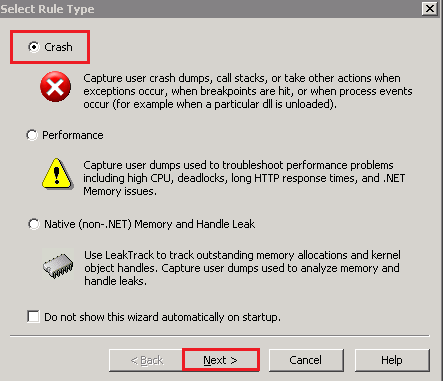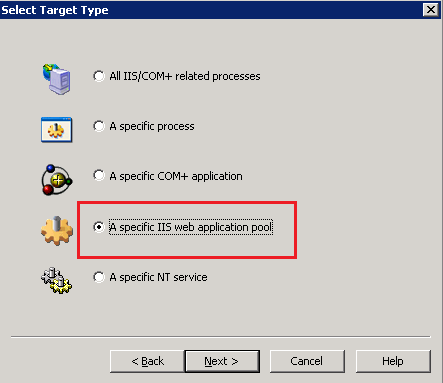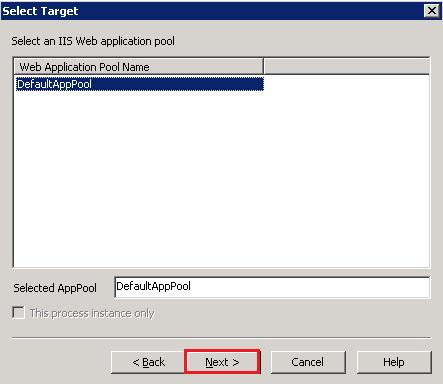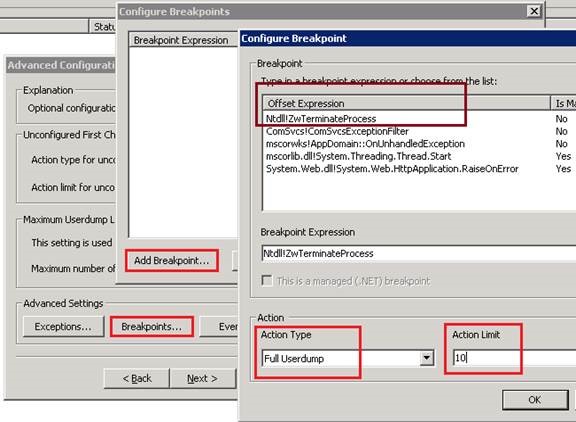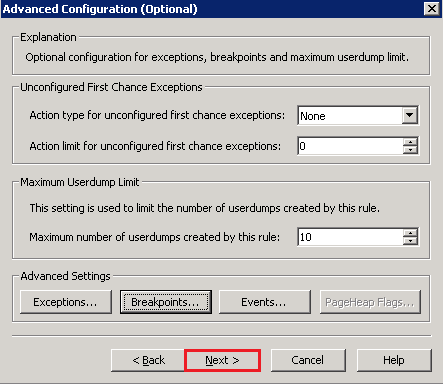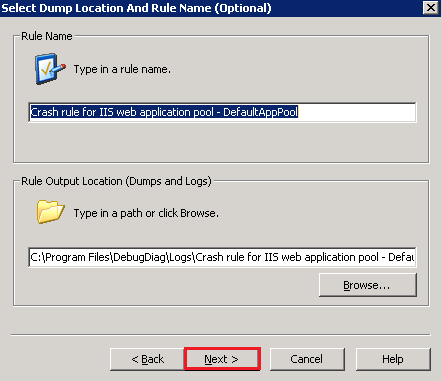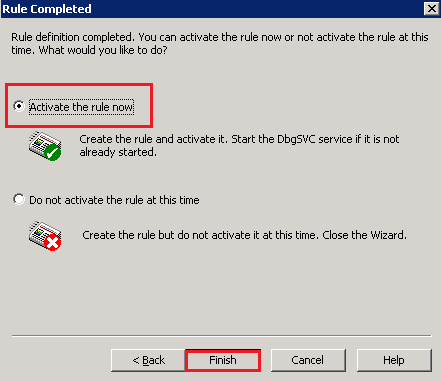Difference between revisions of "Create Agility Crash Dump"
(Created page with "Note: Make sure the dump is not generated by an application pool recycle by checking the event log. *Debug Diagnostic 2.0 can be download at the following URL: https://www.mic...") |
|||
| Line 4: | Line 4: | ||
*Execute DebugDiag 2.0 Collection on the IIS server, the wizard "Select Rule Type" loads | *Execute DebugDiag 2.0 Collection on the IIS server, the wizard "Select Rule Type" loads | ||
*Select "Crash" and then click on "Next >" | *Select "Crash" and then click on "Next >" | ||
| − | + | ||
| + | [[File:SelectRuleType.png]] | ||
| + | |||
*In the window "Select Target Type" | *In the window "Select Target Type" | ||
**Check "A specific IIS web application pool", then click on "Next >" | **Check "A specific IIS web application pool", then click on "Next >" | ||
| Line 12: | Line 14: | ||
The drawback of "A specific process" for a unique instance is you need to recreate the rule each time the process is restarted as his PID would have changed | The drawback of "A specific process" for a unique instance is you need to recreate the rule each time the process is restarted as his PID would have changed | ||
| − | + | [[File:TargetType.png]] | |
*Select the Application Pool facing the crash issue, then click on "Next >" For your site, it should be AgilityNET2 | *Select the Application Pool facing the crash issue, then click on "Next >" For your site, it should be AgilityNET2 | ||
| + | |||
| + | [[File:SelectTarget.png]] | ||
*Add the breakpoint as you can see in the below screenshot | *Add the breakpoint as you can see in the below screenshot | ||
**This allows you to generate a dump as soon as the command "TerminateProcess" is sent in the process without waiting for a complete stop | **This allows you to generate a dump as soon as the command "TerminateProcess" is sent in the process without waiting for a complete stop | ||
**In addition, if a problem is detected by WAS in the process, it will stop it with this command, so without this breakpoint, no dump will be generated while the process is facing a crash | **In addition, if a problem is detected by WAS in the process, it will stop it with this command, so without this breakpoint, no dump will be generated while the process is facing a crash | ||
| − | + | ||
| + | [[File:ConfigureBreakpoint.jpg]] | ||
| + | |||
*Then click on "Next >" | *Then click on "Next >" | ||
| + | [[File:AdvancedConfiguration.png]] | ||
| + | |||
*Choose a name and a location for dumps file, then click on "Next >" | *Choose a name and a location for dumps file, then click on "Next >" | ||
**Setting those dumps on another disk than C:\ is possible | **Setting those dumps on another disk than C:\ is possible | ||
**Please check you have enough available space disk as the dump size will be equal to the memory consumed by the process you are monitoring | **Please check you have enough available space disk as the dump size will be equal to the memory consumed by the process you are monitoring | ||
| + | [[File:SelectDumpLocation.png]] | ||
| + | |||
*In the window "Rule Completed", select "Activate the rule now", and then click on "Finish" | *In the window "Rule Completed", select "Activate the rule now", and then click on "Finish" | ||
**The rule is now configured and ready to generate dumps | **The rule is now configured and ready to generate dumps | ||
| + | [[File:RuleCompleted.png]] | ||
| + | |||
*Check the status is "Active" | *Check the status is "Active" | ||
**If it's not, The "DbgSvc" service is surely not started | **If it's not, The "DbgSvc" service is surely not started | ||
| Line 36: | Line 48: | ||
If you see the following dialog box, choose No because we only need to generate dump files. | If you see the following dialog box, choose No because we only need to generate dump files. | ||
| + | |||
| + | [[File:DebugDiagnosticTool.jpg]] | ||
Revision as of 10:37, 25 July 2016
Note: Make sure the dump is not generated by an application pool recycle by checking the event log.
- Debug Diagnostic 2.0 can be download at the following URL: https://www.microsoft.com/en-us/download/details.aspx?id=49924
If the operating system is 32-bit, install the 32 bit DebugDiagx86.msi. For 64 bit operating system choose the DebugDiagx64.msi.
- Execute DebugDiag 2.0 Collection on the IIS server, the wizard "Select Rule Type" loads
- Select "Crash" and then click on "Next >"
- In the window "Select Target Type"
- Check "A specific IIS web application pool", then click on "Next >"
This will have for effect to only generate a dump on the W3WP.exe process corresponding to your Application Pool
- If you want to monitor every processes owned by IIS, you can select "All IIS/COM+ related processes"
- You can also select "A specific process" to monitor every instances of a process or just a unique one (a specific process with a specific PID)
The drawback of "A specific process" for a unique instance is you need to recreate the rule each time the process is restarted as his PID would have changed
- Select the Application Pool facing the crash issue, then click on "Next >" For your site, it should be AgilityNET2
- Add the breakpoint as you can see in the below screenshot
- This allows you to generate a dump as soon as the command "TerminateProcess" is sent in the process without waiting for a complete stop
- In addition, if a problem is detected by WAS in the process, it will stop it with this command, so without this breakpoint, no dump will be generated while the process is facing a crash
- Then click on "Next >"
- Choose a name and a location for dumps file, then click on "Next >"
- Setting those dumps on another disk than C:\ is possible
- Please check you have enough available space disk as the dump size will be equal to the memory consumed by the process you are monitoring
- In the window "Rule Completed", select "Activate the rule now", and then click on "Finish"
- The rule is now configured and ready to generate dumps
- Check the status is "Active"
- If it's not, The "DbgSvc" service is surely not started
- You can go in "Administrative Tools > Services" and start it
- When a dump will be generated, you'll see the column "UserDump Count" being incremented
The dumps are located by default in "C:\Program Files\DebugDiag\Logs\Crash rule for all IIS_COM+ related processes" or in "C:\Program Files\DebugDiag\Logs\Rule_Name".
If you see the following dialog box, choose No because we only need to generate dump files.
